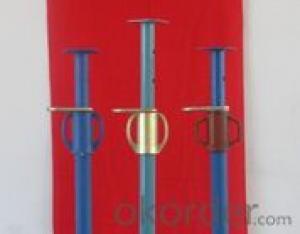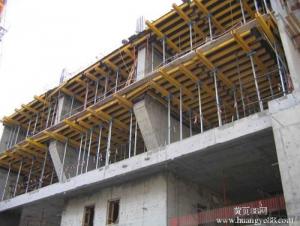The Doka formwork accessories-- steel prop GM-57
- Loading Port:
- Tianjin
- Payment Terms:
- TT OR LC
- Min Order Qty:
- 10000 PCS
- Supply Capability:
- 10000 PCS/month
OKorder Service Pledge
OKorder Financial Service
You Might Also Like
Quick Details
| Model Number: | SXV-GM-57 | ||||
| Size: | 15-17mm/as your demands | Material: | Q195/Q235/etc | Certificate: | ISO 9001:2008/CE/TUV |
| Surface: | Hot-dip galvanization/ electro galvanization /or as your request | Standard: | EN74,BS1139,JIS,ISO9001:2008 | Weight: | 5000kg,0.4-0.6kg/pcs or as your demands |
| Use: | suit for PERI/DOKA/MEVA/etc | Type of Mould: | steel mould; aluminum mould | Mould Quantity: | more than 10 sets |
Packaging & Delivery
| Packaging Detail: | in steel plate or plywood plate, or as your request |
| Delivery Detail: | 15-30 days after confirmation |
Specifications
formwork parts
1.Material:Q195/Q235/etc,
2.Standard:EN74,BS1139,JIS,ISO9001:2008
3.OEM service
The Doka formwork accessories-- steel prop GM-57
Name: The formwork parts -- SXV-GM-057;
Produce Equipment: 350kg and 500kg inter- Medium Frequency melting Furnace--two pieces of each;
Produce Technology: sodium silicate precision casting; silica sol precision casting;pressing;
Produce Capacity: 100 tons/month
Mould: aluminum mold and steel mould, 6 sets of each;
Output: 3000 pcs/day
Item | formwork accessories |
Material | Q195/Q235/etc |
Dimensions | Φ 20-40/L=155-200;Φ25/L=200;as your demands |
Surface | Hot-dip galvanization/ electro galvanization /painted/or as your request |
Standard | EN74,BS1139,JIS,ISO9001:2008 |
Note | OEM service is available |
MOQ | 1000pieces |
Package | in steel plate or plywood plate, or as your request |
Payment Terms | TT,L/C, we can contact in detail |
Delivery Time | 20-30days |
- Q: Can steel props be used for temporary support in offshore platforms?
- Yes, steel props can be used for temporary support in offshore platforms. Steel props are commonly used in construction for supporting temporary structures or providing additional support to existing structures. In the case of offshore platforms, steel props can be used to provide temporary support during construction, maintenance, or repair activities. Offshore platforms are subjected to various loads and forces, including waves, wind, and the weight of equipment and personnel. During construction or maintenance work, additional loads may be applied, which can require temporary support to ensure the stability and safety of the platform. Steel props are typically made of high-strength steel and can be easily adjusted to the required height and load-bearing capacity. They provide a stable and reliable means of supporting structures temporarily, allowing for the completion of necessary work. However, it is important to ensure that the steel props used for temporary support in offshore platforms are designed and manufactured to meet the specific requirements and safety standards of the offshore industry. This includes considering factors such as corrosion resistance, load capacity, and compliance with relevant regulations and guidelines. In summary, steel props can be used for temporary support in offshore platforms, but it is crucial to choose appropriate props that are designed and manufactured to meet the specific needs of the offshore environment to ensure the safety and stability of the platform.
- Q: Can a steel prop be adjusted in height?
- Yes, a steel prop can be adjusted in height. Steel props are commonly used in construction and are designed with an adjustable mechanism that allows for easy height modification to suit various building needs.
- Q: Can steel props be used to support ceilings?
- Yes, steel props can be used to support ceilings. Steel props, also known as adjustable steel props or steel acrow props, are commonly used in construction to provide temporary support to ceilings, walls, and other structural elements. These props are adjustable in height, making them suitable for various ceiling heights. They are strong and sturdy, capable of bearing heavy loads, and can be easily installed and adjusted to provide the necessary support during construction or renovation projects.
- Q: Can steel props be used in supporting temporary playground equipment?
- Yes, steel props can be used in supporting temporary playground equipment. Steel props are commonly used in construction and engineering to provide temporary support to structures. They are strong, durable, and can withstand heavy loads, making them suitable for supporting playground equipment. However, it is important to ensure that the steel props are properly installed, anchored, and meet the necessary safety standards to prevent any accidents or injuries. Regular inspections and maintenance should also be performed to ensure the safety and stability of the playground equipment.
- Q: Are steel props adjustable in height?
- Yes, steel props are adjustable in height. Steel props, also known as steel acrow props or telescopic props, are commonly used in construction and temporary support systems. They are designed to provide temporary support to structures, such as walls, beams, or slabs, during construction or renovation. One of the key features of steel props is their ability to be adjusted in height. This allows for flexibility in adapting to various construction requirements. The props consist of an inner tube and an outer tube, which can be extended or retracted to achieve the desired height. The adjustment mechanism typically involves a pin or a screw system that allows for easy and secure height adjustment. To adjust the height of a steel prop, you need to loosen the locking mechanism, extend or retract the inner tube to the desired height, and then lock it in place. This adjustability feature makes steel props versatile and adaptable to different construction scenarios. Furthermore, the adjustable height feature of steel props ensures that they can be used in different stages of construction, where the height requirements may vary. They can be easily extended or shortened as needed, providing stability and support throughout the construction process. In summary, steel props are indeed adjustable in height, making them a valuable tool in the construction industry for providing temporary support and stability to structures during construction or renovation projects.
- Q: How do you calculate the number of steel props required for a specific task?
- To determine the required number of steel props for a specific task, several factors need to be taken into consideration. These factors include the weight and size of the load to be supported, the distance between the props, and the strength and capacity of each individual prop. 1. Start by determining the weight and size of the load. This initial step will provide insight into the load-bearing capacity necessary for the steel props. 2. Next, determine the spacing between the props. This will depend on the load's size and weight distribution. It is important to ensure that the spacing provides sufficient support and stability for the load. 3. Verify the load capacity of the steel props. Manufacturers usually specify the load capacity of each prop. Check the load capacity of the existing props or those intended for purchase. This will help establish the maximum weight each prop can bear. 4. Calculate the required load-bearing capacity by dividing the total weight of the load by the load capacity of a single prop. This calculation will provide an estimate of the number of props needed to support the load. 5. Account for safety factors. It is crucial to incorporate safety margins when determining the number of steel props required. It is advisable to add one or two extra props to ensure additional support and accommodate any uncertainties or variations in load distribution. 6. Consider the type and quality of the props. Different types of steel props possess varying load-bearing capacities. Evaluate the type and quality of the props being used to ensure they meet the necessary safety standards and regulations. 7. Seek consultation from a structural engineer or an expert. If there is uncertainty or if the task involves complex load calculations, it is recommended to consult with a structural engineer or an expert in the field. They can provide guidance and assist in accurately calculating the required number of steel props. Always prioritize safety and adhere to relevant regulations and guidelines when calculating the number of steel props required for a specific task.
- Q: How do steel props compare to wooden props in terms of strength?
- In terms of strength, steel props surpass wooden props. Steel, being a highly durable and sturdy material, has the capacity to bear heavy loads and offer outstanding structural support. Its high tensile strength enables it to withstand pressure without bending or breaking. Conversely, wooden props, although able to support specific loads, are vulnerable to warping, splitting, and deterioration over time. They lack the resistance to weight and external forces that steel props possess. Consequently, when it comes to strength and durability, steel props are the preferable option for construction or structural support purposes.
- Q: What are the safety measures of steel support construction
- Improve the system, strengthen management, to solve the construction of the following work and problems: 1, regulate the side of the entrance and exit protection. Pay attention to wear safety helmet and high operating safety belt; according to the provisions of the use of qualified safety nets, safety helmets and seat belts
- Q: What is the weight of a typical steel prop?
- The size and specifications of a typical steel prop can cause its weight to fluctuate. On average, a standard steel prop generally falls between 10 and 15 kilograms (22 to 33 pounds) in weight. It is crucial to understand that the weight can differ due to factors like the prop's length, diameter, and the materials used in its construction.
- Q: Can steel props be used in telecommunications tower construction?
- Yes, steel props can be used in telecommunications tower construction. Steel props, also known as temporary support systems or scaffolding, are commonly used in construction projects to provide structural support and stability. They can be used to support various components of a telecommunications tower, such as the mast, antennas, and equipment platforms, during the construction process. Steel props are made of high-strength steel and are adjustable in height, allowing for flexibility in tower construction. They are designed to withstand heavy loads and provide stability to the structure. Additionally, steel props are easy to install, dismantle, and reposition, making them a suitable choice for the dynamic nature of telecommunications tower construction.
Send your message to us
The Doka formwork accessories-- steel prop GM-57
- Loading Port:
- Tianjin
- Payment Terms:
- TT OR LC
- Min Order Qty:
- 10000 PCS
- Supply Capability:
- 10000 PCS/month
OKorder Service Pledge
OKorder Financial Service
Similar products
Hot products
Hot Searches
Related keywords






















